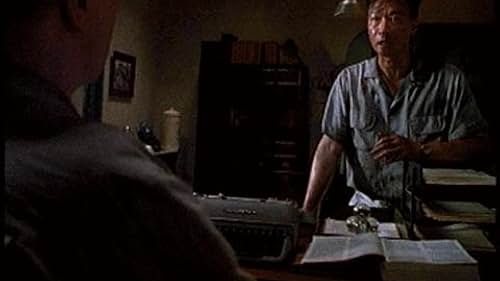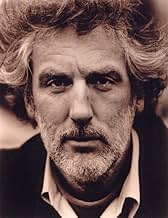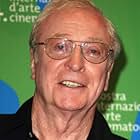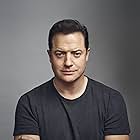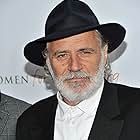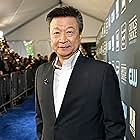An old British reporter vies with a young U.S. doctor for the affections of a beautiful Vietnamese woman.An old British reporter vies with a young U.S. doctor for the affections of a beautiful Vietnamese woman.An old British reporter vies with a young U.S. doctor for the affections of a beautiful Vietnamese woman.
- Nominated for 1 Oscar
- 13 wins & 14 nominations total
Do Thi Hai Yen
- Phuong
- (as Thi Hai Yen Do)
Rade Serbedzija
- Inspector Vigot
- (as Rade Sherbedgia)
Ha Phong Nguyen
- Muoi's Henchman
- (as Nguyen Ha Phong)
- Director
- Writers
- All cast & crew
- Production, box office & more at IMDbPro
Storyline
Did you know
- TriviaDirector Phillip Noyce wanted Heath Ledger to play the role of Alden Pyle, but was happy with Brendan Fraser's work in this movie.
- GoofsWhen Fowler is reading his report of the massacre in The Times, the text says "120 kilometers". In the unlikely event that an English journalist in the 1950s would use kilometers instead of miles, he would have spelled it "kilometres". Also, the text reads that Phat Diem is "120 kilometers north of Hanoi" when, in fact, it is 120 kilometers SOUTH of Hanoi.
- Quotes
Thomas Fowler: I know I am behaving badly, but I have every intention of behaving badly. As a matter of fact, this is exactly the kind of situation where one should behave badly.
- ConnectionsFeatured in Anatomy of a Scene: The Quiet American (2002)
- SoundtracksNuoc Non Lam Son
Written by Hoang Quy
Performed by Manh Phat
Featured review
I don't understand why the studio satraps thought it necessary to embargo this film after 9/11, requiring persuasion on Michael Caine's part to get it to limited release now so as to qualify for Oscar nominations. The American role in Viet Nam is the subject of hundreds of books and countless articles - and not a few films. There is nothing unhealthy about the continuing debate and contrary to what some opine, I doubt American policy vis-a-vis Iraq has much lineal connection to the troubled saga of U.S. involvement in Indo-China, or its partial successor in hapless interest, the Republic of Viet Nam.
The Graham Green story has been filmed before (1958) but this is a pungent, attention-grabbing version, filmed in various parts of Viet Nam. The sultry and grasping humidity of the land almost comes off the screen. The story takes place in 1952 as the inept and poorly led French stumble towards their ultimate debacle at Dien Bien Phu (anyone interested in this story should start and finish with Bernard Fall's remarkable account of the French Army's Super-Alamo).
Caine, a Brit named Fowler, assures Brendan Fraser, a putative U.S. humanitarian officer named Pyle, that he is a "reporter," not a "correspondent." The difference to the easy-living Fowler is that the latter has a viewpoint, perhaps even a cause, while the former, as Sergeant Friday would say, only wants the facts.
This film really belongs to Caine and Fraser but one other character, the stunning Do Thi Hai Yep, Fowler's live-in girlfriend, deserves mention. She lights up the screen with both her calculating passion for, first, Fowler and then Pyle. Her character is realistically complex: I knew a number of such women when I was an Army officer and although the phrase isn't used here, she's a perfect example of the desperately ambitious, beautiful mistress whose only long-term goal is to be taken to "The Land of the Big P.X."
A series of experiences transform both Fowler and Pyle. Several of the scenes of violence are real enough but the music is intrusive. You don't hear music when people are dying around you. At least not performed by an orchestra.
This is the third recent film in which Michael Caine distinguishes himself by the depth of his acting (the others being "The Cider House Rules" and "Last Orders"). Caine's Fowler leaves us wondering as to what his motives are as he slowly changes before us. There's no clear answer and room for argument. His Fowler is both disturbing and ingratiating.
The audience in the East Village theater where I saw "The Quiet American" today clearly was made up of folks whose minds were settled as to U.S. involvement in Indo-China, never mind the later escalation in Viet Nam. Their grunts and laughs at certain points reflected their views. But the story told here is a faithful mirror of what in 1952 were complex questions in a scary world made scary by communism, not the liberal democracies. That mistakes of a grievous nature were made may be clear today but the road was ill-illuminated then. This film, and Caine's portrayal in particular, reflects the contemporary confusion and the unravelling of any hopes for a peaceful reunification of the two Viet Nams after the French defeat.
I hope this film gets a very wide distribution after it finishes its two-week Oscar-qualifying run.
8/10.
The Graham Green story has been filmed before (1958) but this is a pungent, attention-grabbing version, filmed in various parts of Viet Nam. The sultry and grasping humidity of the land almost comes off the screen. The story takes place in 1952 as the inept and poorly led French stumble towards their ultimate debacle at Dien Bien Phu (anyone interested in this story should start and finish with Bernard Fall's remarkable account of the French Army's Super-Alamo).
Caine, a Brit named Fowler, assures Brendan Fraser, a putative U.S. humanitarian officer named Pyle, that he is a "reporter," not a "correspondent." The difference to the easy-living Fowler is that the latter has a viewpoint, perhaps even a cause, while the former, as Sergeant Friday would say, only wants the facts.
This film really belongs to Caine and Fraser but one other character, the stunning Do Thi Hai Yep, Fowler's live-in girlfriend, deserves mention. She lights up the screen with both her calculating passion for, first, Fowler and then Pyle. Her character is realistically complex: I knew a number of such women when I was an Army officer and although the phrase isn't used here, she's a perfect example of the desperately ambitious, beautiful mistress whose only long-term goal is to be taken to "The Land of the Big P.X."
A series of experiences transform both Fowler and Pyle. Several of the scenes of violence are real enough but the music is intrusive. You don't hear music when people are dying around you. At least not performed by an orchestra.
This is the third recent film in which Michael Caine distinguishes himself by the depth of his acting (the others being "The Cider House Rules" and "Last Orders"). Caine's Fowler leaves us wondering as to what his motives are as he slowly changes before us. There's no clear answer and room for argument. His Fowler is both disturbing and ingratiating.
The audience in the East Village theater where I saw "The Quiet American" today clearly was made up of folks whose minds were settled as to U.S. involvement in Indo-China, never mind the later escalation in Viet Nam. Their grunts and laughs at certain points reflected their views. But the story told here is a faithful mirror of what in 1952 were complex questions in a scary world made scary by communism, not the liberal democracies. That mistakes of a grievous nature were made may be clear today but the road was ill-illuminated then. This film, and Caine's portrayal in particular, reflects the contemporary confusion and the unravelling of any hopes for a peaceful reunification of the two Viet Nams after the French defeat.
I hope this film gets a very wide distribution after it finishes its two-week Oscar-qualifying run.
8/10.
- How long is The Quiet American?Powered by Alexa
Details
- Release date
- Countries of origin
- Official sites
- Languages
- Also known as
- Graham Greene's Quiet American
- Filming locations
- Production companies
- See more company credits at IMDbPro
Box office
- Budget
- $30,000,000 (estimated)
- Gross US & Canada
- $12,988,801
- Opening weekend US & Canada
- $101,663
- Nov 24, 2002
- Gross worldwide
- $27,674,124
- Runtime1 hour 41 minutes
- Color
- Sound mix
- Aspect ratio
- 2.35 : 1
Contribute to this page
Suggest an edit or add missing content


